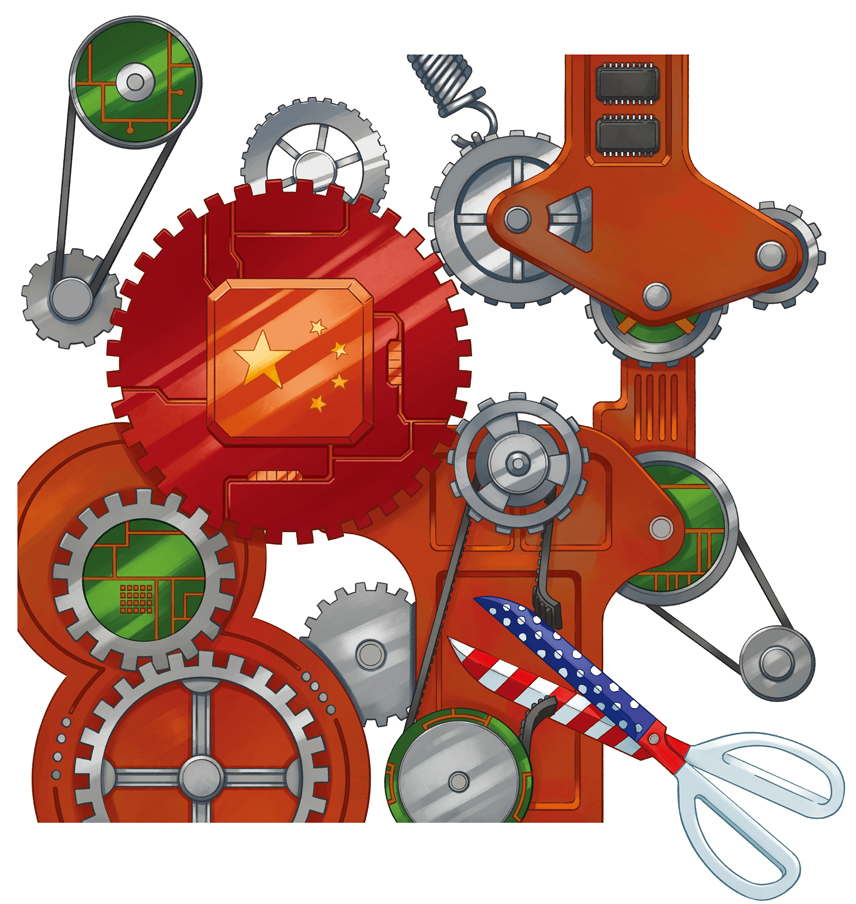 China has for the first time taken the top position in the Nature Index as the biggest producer of high-quality research in chemistry. What will the future of China science look like?
China has for the first time taken the top position in the Nature Index as the biggest producer of high-quality research in chemistry. What will the future of China science look like?
Quantum physics may be science on an impossibly small scale but it is one field where China is staking a massive leadership role. In February, researchers in Hefei forged a quantum connection between clusters of atoms 50km apart in an optical fiber, meaning that any changes in one group’s quantum state instantly affected the other. This 50km “entanglement”—the longest distance achieved anywhere—could eventually lead to a quantum internet that would be near-instantaneous and impervious to eavesdropping.
Quantum communications is just one area where Chinese scientists are taking a leading role—others include artificial intelligence (AI), biotechnology and materials genome engineering. Together they are allowing China to “reassert” its position as a scientific powerhouse, centuries after the Middle Kingdom wowed the world with the “four great inventions” of the compass, paper, printing and gunpowder.
China’s modern-day scientific prowess is backed by unprecedented state spending on R&D. Expressed in Purchasing Power Parity (PPP), China’s investment in R&D was $370.6 billion in 2017, second only to the United States who spent $476.5 billion. And China likely overtook the US in research funding in 2019 for the first time, based on projections by the US National Science Board (although the figures are yet to be compiled at the time of writing) . In terms of global scientific R&D spending, China has contributed 32% of all growth since 2000, compared with 20% for the US and 17% for the European Union.
The Chinese government’s “open checkbook” has bought the country a lot of impressive big-science hardware—the country now boasts the world’s most powerful supercomputer, the biggest radio telescope and, by some measures, the largest gene-sequencing center. But Beijing’s willingness to spend belies its poor standing in a crucial indicator of science leadership—the number of Nobel Laureates. Only one Chinese national has ever won a Nobel Prize in a scientific discipline—Tu Youyou, recognized in 2015 for her role in the development of an antimalarial drug.
By contrast, the US has produced 302 Nobel Laureates in chemistry, medicine and physics since the year 1900—nearly one-third of which have been awarded since 2000. Japanese scientists have also fared well, with 24 Nobel Prize winners since 1949.
“Money is not the issue so much,” says Denis Simon, who has studied Chinese science for 40 years and is the executive vice chancellor of Duke Kunshan University. “It’s how you use the money. Money doesn’t buy innovation. What buys innovation is inspired thought and willingness to take risks.”
Countries that place more emphasis on independent free thinking seem to have done better in the Nobel Prize rankings, but China’s ever-greater science proficiency is testing the hypothesis that it cannot be achieved in a highly centralized and hierarchal system as well.
Rising up the ranks
Nobel Laureates aside, there are other indicators that show that China is closing in on the US as a science superpower. The country’s scientists filed 49% of all related patents worldwide in 2018, although it is important to highlight that in the view of some experts, these numbers are skewed by various factors, such as the refiling of patents already filed elsewhere. In addition, China is steadily increasing its percentage of research articles published in authoritative publications, from just 5% in 2000 to 21% in 2018. The US remains dominant in its proportion of highly cited articles, followed by the EU, but China’s numbers are growing.
China’s recent scientific advancements in the past two decades are especially notable given the country’s fraught history. Its scientific community was devastated during the 1966-1976 Cultural Revolution, when many academics were denounced as “counterrevolutionary” and some universities were closed, halting almost all research and scientific training.
Only after China adopted its famous policy of “Reform and Opening Up” in 1978 did the research community begin to regrow around its stumps. In the four decades since, the economic development and international contacts have been instrumental in enabling science to flourish in China, according to Cong Cao, who studies Chinese science policy at the University of Nottingham in Ningbo, a major port and industrial hub in east China.
“We really want to see this kind of stable environment continue,” says Cao. “For the past 40 years, China has basically been a follower in scientific research. Now, in certain areas, the Chinese side is approaching the frontier of science,” he says.
“Some parts of China’s scientific system have been functional for decades,” says Caroline Wagner, a professor at Ohio State University who has studied the scientific impact of foreign-trained Chinese researchers after they return to China. “Food science, agricultural science, soil, and engineering are fields where China’s had strong research capabilities. It just hasn’t participated in the world system of publication and validation,” says Wagner.
Science excellence
China has broadened its scientific gaze, beyond the areas mentioned by Wagner, to cover some of the most exciting topics and challenges in science today. China leads the world in 33 out of 137 research fronts, particularly in computer science, chemistry, engineering, material sciences and mathematics,, according to a report published in November 2019 by the Chinese Academy of Sciences (CAS) and Clarivate Analytics, a US data and analytics company.
The progress has been particularly visible in the field of chemistry, where for the first time, China last year dethroned the US as the biggest producer of high-quality research papers. China’s research output in 2019 was almost double the combined share of India, Japan and South Korea, which all ranked in the top 10.
The COVID-19 outbreak, first detected in Wuhan, provides a challenge for China’s scientists and an opportunity in terms of the development of being first in the development of the vaccine. If they can do it, it would be a gamechanger. The deadly outbreak has also highlighted China’s capabilities in AI and computer science, which has seen sweeping national investments in recent years.
The ability of domestic research institutions and companies to harness big data to feed their AI tools gives China a leg-up in the next round of scientific research and innovation, according to academics. “I think big data is an area China does have advantages in parts because they have a few dominant apps like WeChat that everybody uses,” says Yu Zhou, a professor in the Department of Earth Science and Geography at Vassar College in the US. “You don’t have that in the US.”

Shortcomings
China still has shortcomings to overcome before it can be considered a global leader in science. Despite lavish spending, the global business consultancy McKinsey noted in a 2015 report that inefficient government funding, among other factors, was stifling China’s endeavors to promote science-based innovations. Five years on, this remains a problem, according to Zhou, who says an immature system of evaluating science innovations has led to “state administrators from outside who don’t know what they’re doing and are just bureaucratic bean counting.”
The country still lacks well-established links between businesses and universities, which significantly limits knowledge transfers. Although this relationship is difficult to quantify, Times Higher Education examined how universities work on research with industry, and noted that in 2016 more than “6% of US publications [were] joint efforts between the academy and industry, compared with just 2.7% in China.”
While China ranked second in the CAS-Clarivate report identifying the best and emerging specialty areas in scientific research, it was dwarfed by the US, which claimed the top spot on 80 research fronts.
This may be partly because China has been selective in its approach, opting to channel resources into science that will not only help Beijing project its power but also respond to its people’s particular problems.
“The state has the overview about the areas where China needs to invest more,” says Zhou. She points to China’s massive investments in renewable energy and electric vehicles as an example. “The state has this function of telling people where you should put more money. Some areas, like environmental science, make a lot of sense.”
This methodical approach reflects China’s attitude to science. In the last 40 years, China’s leaders tackled the country’s lagging status with a top-down approach and long-term strategic planning. When it comes to the longstanding view that this approach stifles innovation, Wagner, in a soon-to-be published study, disagrees.
“What we found is that at the disciplinary level, China’s publications in physical sciences were highly creative when compared to the field as a whole, much more creative than other parts of China’s work,” she says. “The physical sciences stood out as highly creative. Measures of technology research was found to be moderately creative, but biology did not appear to be creative.”
“We were surprised with the results of the work, finding that China’s publications already display world-class level of creativity,” says Wagner.
China’s approach
Authorities are orchestrating the development of a scientific establishment—one pillar of which is a core group of elite universities known as the C9 that includes Tsinghua and Peking in Beijing, and Fudan in Shanghai. Another key plank has been the Thousand Talents Program (TTP), a successful scheme aimed at luring top researchers to China with lab space, lavish salaries, research funding and other incentives.
“Around the late 1990s, the Chinese decided to double or triple the levels of enrollment in university, but what they couldn’t do was hire more good faculty. They just couldn’t get that many,” says Simon at Duke University. But the TTP has helped plug the deficit in training younger generations of Chinese researchers.
Simon believes the success of the TPP at the recruitment of top scientific talent has only become more important because China could face a potential talent shortage due to the notorious one-child policy. China has struggled to engineer a baby boom after scrapping the notorious policy in 2015, which could shrink the future scientific workforce.
Increasingly strict controls on internet access are also a potential long-term hindrance toward scientific excellence in China. A common gripe among the country’s academics is that internet accessibility is a major obstacle to their research. Wagner from Ohio State University says free flow of knowledge and information is critical to innovation.
Many researchers routinely bypass internet controls, but ever-tightening restrictions on the flow of information risk making international collaboration more difficult and threaten China’s place in science and technology globally.
“Studies demonstrate the benefits of openness,” says Wagner. “You can’t get around the need to share findings, data, and insights. If that gets closed off, China will drop behind and the world will be deprived of China’s input. There are no winners in that scenario”
The China-US relationship has also grown increasingly toxic since President Trump took office three years ago, ramping up the prospect of the world’s top-two economies “decoupling.” Researchers are in no doubt that this would be a disaster for the scientific communities of both countries.
“It’s not good for science globally,” said Cong from Ningbo. “There’s no doubt about that because each country is constrained by resources. No country in the world can pursue every line of research, so that’s really where you need to be collaborative. If decoupling between China and the US really happens, it’s not going to be good for China and for other countries.”
But there is also the argument that Chinese and American scientific communities are already too intertwined for any decoupling to have a serious impact, according to Simon.
“The government-to-government cooperation is important, but is not the defining dimension of the science and technology cooperation between China and the US,” says Simon. “It would be very hard, at least from my perspective, for the US government to disengage and simply shut down all of that collaboration. There’s just so much going on I don’t know if anyone would know where to go to stop it or to shut the spigot off.”
Just how much a potential delinking would really hurt China is up for debate. February’s successful quantum entanglement experiment in Hefei underscores how Chinese scientists are operating at the cutting edge in many ways on their own.
“The US remains ahead, but if you’re looking at where we will be five, 10 years from now, the trend lines are all extremely positive for China,” says Simon. “The Chinese have corrected a lot of the problems that were inherent in their system. They’re all the time trying to get higher-yield performance from their scientific community. And I think they’re starting to succeed.”

















